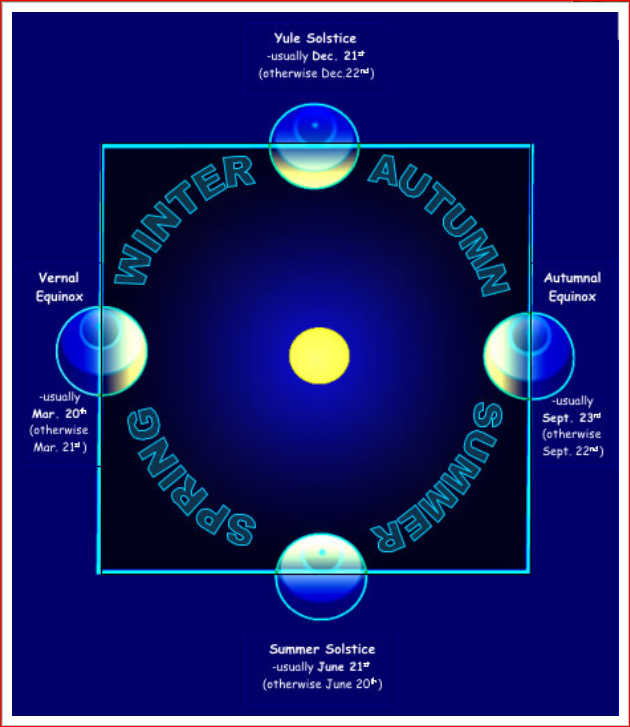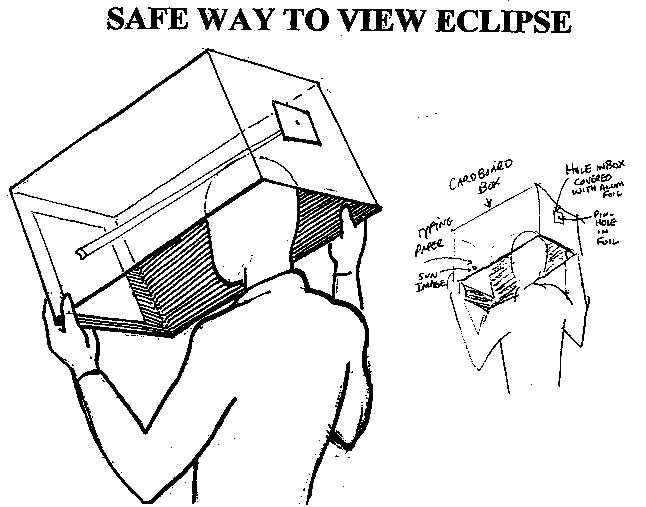
This diagram shows the position of the Earth, in relation to the Sun, at the time of the Summer Solstice, as well as the other solstice and equinoxes of the year, for Earth's Northern Hemisphere.
(Graphic Source: © Copyright 1999, Eric G. Canali, former Floor Operations Manager of Pittsburgh's original Buhl Planetarium and Institute of Popular Science and Founder of the South Hills Backyard Astronomers amateur astronomy club; permission granted for only non-profit use with credit to author.)
By Glenn A. Walsh
Reporting for SpaceWatchtower
This morning, Summer begins in the
Northern Hemisphere of Earth, while at the same time, Winter begins
in the Southern Hemisphere.
For 2018, the season of Summer begins
in Earth's Northern Hemisphere (and the season of Winter begins in
the Southern Hemisphere) at the moment of the June Solstice: Thursday
Morning, 2018 June 21 at 6:07 a.m. Eastern Daylight Saving Time (EDT)
/ 10:07 Coordinated Universal Time (UTC) (the moment of the posting of this blog-post) .
In etymology, the word solstice
comes from the Latin terms Sol (Sun) and sistere
(to stand still). In ancient times, astronomers / astrologers /
priests recognized that on one day of the year (in the Northern
Hemisphere, on or near the day we now call June 21), the Sun would
appear to stand-still as Sol reaches its highest point in the sky for the entire year. The
motion of the Sun's apparent path in the sky (what is known
astronomically, today, as the Sun's declination) would cease
on this day, before appearing to reverse direction.
Although the Summer months in the
Northern Hemisphere are known for the year's warmest weather, the
Earth is actually at the point in its orbit farthest from the Sun
(astronomically known as the point of aphelion) around July 5;
the Earth's closest approach to the Sun (perihelion) each year
is around January 2. Hence, in general, the distance from the Earth
to the Sun is not the major factor determining the heat of Summer or
the cold of Winter.
Solar radiation, and hence the heat
from the Sun, depends on the length of daylight and the angle of the
Sun above the horizon. The tilt of the planet's axis toward the Sun
determines the additional and more direct solar radiation received by
a planet's Northern or Southern Hemisphere, and hence, the warmer
season of the respective hemisphere.
While the Sun does have motions, it is
actually the motion of the Earth tilted on its axis 23.43715 degrees
/ 23 degrees, 26 minutes, 13.7 seconds away from the plane of the
ecliptic (Earth's orbital plane around the Sun), while revolving
around the Sun, that causes the Earth's seasons. Hence, as the Earth
arrives at the point in its orbit around the Sun, when the north
polar axis is most directly inclined toward the Sun, this marks the
Summer Solstice in the Northern Hemisphere and the Winter Solstice in
the Southern Hemisphere.
Alternately, the Winter Solstice in the
Northern Hemisphere (the Winter Solstice is always on or near
December 20) occurs when the Earth reaches the point in its orbit
when the North Pole is most directly inclined away from the Sun. And,
conversely, at this time Summer begins in the planet's Southern
Hemisphere.
No matter which hemisphere, the day of
the Summer Solstice always has the most hours and minutes of daylight
(the length of time between sunrise and sunset) for the year, while the Winter Solstice always has the least number
of hours and minutes of daylight for the year. The exact number of
hours and minutes of daylight, for a particular location, depends on
the locale's geographic latitude on the Earth. Astronomers and
long-distance radio enthusiasts, both of whom mostly depend on
non-daylight hours to ply their craft, often prefer the days closer
to the Winter Solstice.
The Vernal Equinox, when the season of
Spring begins in the Northern Hemisphere (and the season of Autumn
begins in the Southern Hemisphere), occurs between the Winter and
Summer Solstices when the Earth reaches the point in its orbit around
the Sun when the Earth's axis is inclined neither toward nor away
from the Sun. Likewise, when the Earth reaches the point in its orbit
around the Sun, between the Summer and Winter Solstices, when the
Earth's axis is inclined neither toward nor away from the Sun, this
is known as the Autumnal Equinox (beginning of Fall or Autumn) in the
Northern Hemisphere; at this time Spring begins in the Southern
Hemisphere. And, half-way between the beginning points of each season
are Cross-Quarter Days, each related to traditional holidays:
Groundhog Day (February 2), May Day (May 1), Lammas Day
(traditionally, the first harvest festival of the year on August 1),
and Halloween (October 31).
In ancient times, the Summer Solstice
was known as Mid-Summer Day, in early calendars observed around June
24. At that time, May 1 to August 1 (i.e. the two Cross-Quarter Days)
was considered the season of Summer. Such early European celebrations
were pre-Christian in origin. Many will associate this ancient
holiday with the famous William Shakespeare play, “A Midsummer
Night's Dream.” Some speculate that the play was written for the
Queen of England, to celebrate the Feast Day of Saint John.
As with the Roman Catholic Church's
decision to Christianize the pagan Winter Solstice festivals with the
introduction of Christmas Day on December 25 (by an early calendar,
December 25 was reckoned as the Winter Solstice), the Church began to
associate the Mid-Summer festivals with the Nativity of Saint John
the Baptist on June 24. In the Christian Bible, the Gospel of Saint
Luke implies that Saint John was born six months before the birth of
Jesus, although no specific birth dates are given.
The most famous celebration of the
Summer Solstice occurs each year at the Stonehenge pre-historic
monument in England. Constructed between 3,000 B.C. and 1,600 B.C. in
three phases, the actual purpose of the landmark is still unclear.
However, it seems to have been associated with burials, originally.
It was also used as a type of astronomical observatory, particularly
for observing the Sun, which was important to help early cultures
make annual decisions regarding agriculture.
Stonehenge is known as a way for
pre-historic peoples to mark both the Summer and Winter Solstices.
From inside the monument, a viewer facing northeast can watch the Sun
rise (weather-permitting) above a stone outside the main circle of
rocks, known as the Heel Stone, on the day of the Summer Solstice in
the Northern Hemisphere. Although today, due to serious erosion of
the stones, visitors on the Summer Solstice can only walk around the
landmark from a short distance away during this annual event.
Although not as prominent as
Stonehenge, a calendar ring using smaller rocks was also constructed
at Nabta Playa in southern Egypt, perhaps as early as 7,000 years
ago! As with Stonehenge, some stones aligned with sunrise on the day
of the Summer Solstice.
Today, a Stonehenge-like event occurs
each year at the University of Wyoming (UW) Art Museum in Laramie,
Wyoming, free-of-charge to the general public. At 12:00 Noon Mountain
Daylight Saving Time (MDT) / 2:00 p.m. EDT / 18:00 UTC on the day of
the Summer Solstice, visitors can see a single beam of sunlight shine
through a solar tube in the ceiling of the UW Art Museum's Rotunda
Gallery; the beam of sunlight then shines onto a 1923 Peace Silver
Dollar embedded in the floor of the Museum's Rotunda Gallery.
Visitors are encouraged to arrive at the museum by 11:30 a.m. MDT /
1:30 p.m. EDT / 17:30 UTC, to view this rather unique architectural
feature.
The bright Star Spica (Alpha Virginis),
the brightest star in the Constellation Virgo the Virgin and the 16th
brightest star in Earth's night sky (Apparent Visual Magnitude: +
0.97), may have helped develop another one of civilization's early
calendars. A calendar of ancient Armenia used the year's first
sighting of Spica in the dawn sky, a few days before the Summer
Solstice, to mark the beginning of the New Year for this particular
calendar. The development of this calendar somewhat coincided with
the beginning of agriculture in Armenia.
Internet Links to Additional Information ---
Summer Solstice:
Link 1 >>> http://scienceworld.wolfram.com/astronomy/SummerSolstice.html
Link 2 >>> http://en.wikipedia.org/wiki/Summer_solstice
Season of Summer: Link >>> http://en.wikipedia.org/wiki/Summer
History of Mid-Summer: Link >>> http://en.wikipedia.org/wiki/Midsummer
Summer "Solstice Day" Annual Free-of-Charge Day (With Snowballs !), 1985 to 1991, at Pittsburgh's original Buhl Planetarium and Institute of Popular Science (a.k.a. Buhl Science Center):
Link >>> http://spacewatchtower.blogspot.com/2015/06/snowballs-on-first-day-of-summer.html
Stonehenge: Link >>> https://en.wikipedia.org/wiki/Stonehenge
News Release - University of Wyoming Stonehenge-type event:
Link >>> https://www.uwyo.edu/uw/news/2018/06/uw-art-museum-to-celebrate-summer-solstice-june-21.html
Star Spica: Link >>> https://en.wikipedia.org/wiki/Spica
Related Blog Posts ---
"Science Experiments Children & Teens Can Do At Home !" 2018 June 5.
Link >>> http://spacewatchtower.blogspot.com/2018/06/science-experiments-children-teens-can.html
"Snowballs on the First Day of Summer!" 2015 June 21.
Link >>> http://spacewatchtower.blogspot.com/2015/06/snowballs-on-first-day-of-summer.html
Source: Glenn A. Walsh Reporting for SpaceWatchtower, a project of Friends of the Zeiss.
2018 June 21.
Like This Post? - Please Share!
More Astronomy & Science News - SpaceWatchtower Twitter Feed:
Link >>> https://twitter.com/spacewatchtower
Astronomy & Science Links: Link >>> http://buhlplanetarium.tripod.com/#sciencelinks
Want to receive SpaceWatchtower blog posts in your in-box ?
Send request to < spacewatchtower@planetarium.cc >.
gaw
Glenn A. Walsh --- < http://buhlplanetarium2.tripod.com/weblog/spacewatchtower/gaw/ >
Electronic Mail: < gawalsh@planetarium.cc >
Project Director, Friends of the Zeiss: < http://buhlplanetarium.tripod.com/fotz/ >
SpaceWatchtower Editor / Author: < http://spacewatchtower.blogspot.com/ >
Formerly Astronomical Observatory Coordinator & Planetarium Lecturer, original Buhl Planetarium & Institute of Popular Science, Pittsburgh's science & technology museum from 1939 to 1991.
Author of History Web Sites on the Internet --
* Buhl Planetarium, Pittsburgh:
< http://www.planetarium.
* Adler Planetarium, Chicago:
< http://adlerplanetarium.
* Astronomer, Educator, Optician John A. Brashear:
< http://johnbrashear.tripod.com >
* Andrew Carnegie & Carnegie Libraries:
< http://www.andrewcarnegie.

